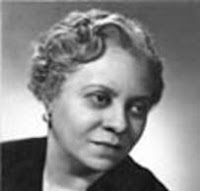Florence B. Price is profiled at AfriClassical.com,
which
features a comprehensive Works List and a Bibliography by Prof.
Dominique-René de Lerma, www.CasaMusicaledeLerma.com.Women's Voices For Change
March 8, 2013
In 1933, at the Chicago Auditorium Theater, the Chicago Symphony Orchestra played the world premiere of Symphony No. 1 in E Minor,
by Florence Beatrice Price. For Florence, it was a monumental moment.
For the country, it was a historic moment—the first time that a major
U.S. orchestra played a symphony by an African-American woman composer.
The
premiere of her piece catapulted Florence into the spotlight, but her
earlier career—and even her career from that triumphant point on—was
anything but an easy fight. In fact, she continued to wage an uphill
battle—a battle much larger than any war that pure talent and musical
skill could win. It was a battle in which the entire nation was
embroiled—a dangerous mélange of segregation, Jim Crow laws, entrenched
racism, and sexism.
Florence
Beatrice Smith, born in 1887, grew up in an affluent and integrated
African-American community in Little Rock, Arkansas. She gave her first
piano performance at the age of 4. Her mother, Florence Gulliver, was a
piano teacher; her father, James Smith, was a well-respected and
successful dentist who catered to both white and black clients. In many
ways, her childhood was sheltered from the hurdles most
African-Americans had to face at the turn of the 20th
century. Florence grew up in a household where the love of art,
literature, and classical music was considered a normal part of a
child’s upbringing.
After
graduating from high school as valedictorian at age 14, Florence left
Little Rock in 1904 for the New England Conservatory of Music, one of
the more prestigious institutions of music in the United States. By that
time she was already a published composer. It was expected that she too
would become a piano teacher like her mother and many good
middle-class, educated ladies.
...
She
double-majored in piano and pedagogy. She was the only student, out of a
class of 2,000, who pursued two degrees. The program was rigorous—so
rigorous that Florence was one of only 58 students who actually
graduated. But she had been keeping a secret. Her mother, who was all
too familiar with the obstacles a black woman faced, advised Florence to
represent herself as being of Mexican descent. Florence acquiesced.
Having
gone through a sort of rite of passage via the conservatory, the newly
minted graduate returned to Little Rock in 1906. But her return met a
rapidly changing racial landscape in Arkansas and an even more
tumultuous time in America’s history. The integrated community Florence
had grown up in was no more. Segregation was the new law and the new
norm.
But
Florence was in need of a job and opportunities to perform. She looked
desperately for avenues to do so. When certain houses of music wouldn’t
open themselves up to her, she decided to build her own. For example,
she created the Little Rock Club of Musicians in response to being
rejected by the Arkansas Music Teachers’ Association, an all-white
group. She would spend the next few years taking on various jobs
teaching music at neighboring black schools, since white schools
consistently shunned her. From 1908 to 1910, Florence lived in Atlanta,
Georgia, heading up the music department at Clark University; she would
become pivotal to the university’s creation of its glee clubs, which are
now widely respected.
No
longer a teenager, no longer a new graduate looking for work, Florence
was in her mid-twenties and in love with Thomas Price, a lawyer living
in Little Rock.
Although
she ran to Chicago out of fear for the safety of her family, it was
this city that would give Florence her monumental first—the world
premiere of her symphony. Florence flourished in Chicago. She joined the
National Association of Negro Musicians. It was in this group that she
met several emerging musicians, like the young Marian Anderson, who
would herself go on to break many racial barriers and play a major role
in Florence’s career.
...
The financial
stresses bled her marriage, and Thomas became abusive. After 15 years of
marriage, Florence filed for divorce. In 1930s America, this was a bold
move for a woman, white or black. To provide for her family, she would
soon echo her mother’s role and offer music lessons in her home.
Florence didn’t mourn Thomas much, or at least for too long. She soon
married Pusey Dell Arnett. But, in another bold move for her time, she
kept the Price name. She was known professionally as Florence Price.
That wasn’t going to change.
It was
between the ending of the first marriage and the beginning of the new
one that Florence fine-tuned her groundbreaking composition, Symphony in E Minor—evidence
of the old adage that when one door closes, another opens. In 1932, the
piece won the esteemed Wanamaker Prize. When Frederick Stock, the
German director of music for the Chicago Symphony Orchestra, heard
Florence’s composition, it was a moment of blissful serendipity. He had
been looking for a piece that would be the definitive performance for a
concert called the “The Negro in Music” at the Chicago World’s Fair. And
so, on the evening of June 15, 1933 in Chicago, Illinois, an all-white
male orchestra, led by a German conductor, played music composed by a
46-year-old black woman—a breakthrough thanks to Florence Beatrice
Price. (Hear excerpts from her symphony, recorded in 2011 by the New
Black Music Repertory Ensemble, here.)
...
She is now globally renowned as a classical music
icon and an accomplished composer.





No comments:
Post a Comment